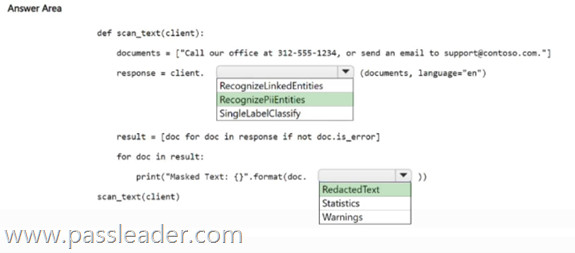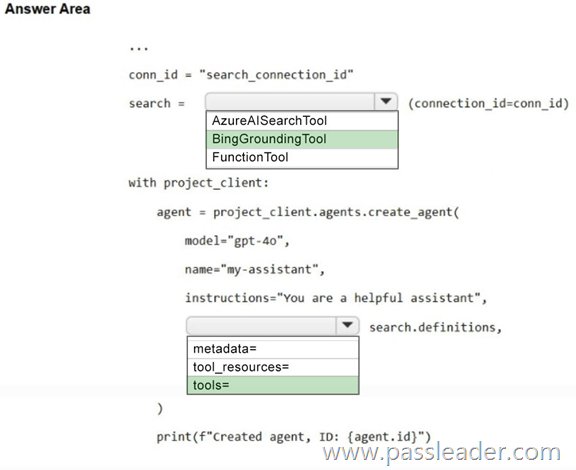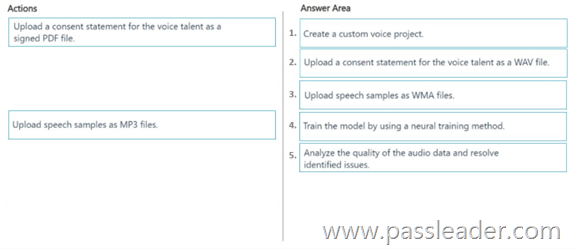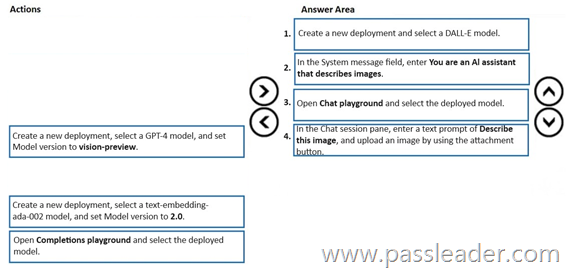Valid AI-102 Dumps shared by PassLeader for Helping Passing AI-102 Exam! PassLeader now offer the newest AI-102 VCE dumps and AI-102 PDF dumps, the PassLeader AI-102 exam questions have been updated and ANSWERS have been corrected, get the newest PassLeader AI-102 dumps with VCE and PDF here: https://www.passleader.com/ai-102.html (481 Q&As Dumps)
BTW, DOWNLOAD part of PassLeader AI-102 dumps from Cloud Storage: https://drive.google.com/drive/folders/1DtLmjMoVidk2fNQdkrtdSFHqFqxHU7re
NEW QUESTION 441
You have an Azure subscription that contains an Azure AI Language custom question answering project named QA1. You need to import question and answer pairs to QA1. Which two file formats can you use? (Each correct answer presents a complete solution. Choose two.)
A. Excel
B. TSV
C. JSON
D. CSV
E. LU
Answer: AB
Explanation:
https://learn.microsoft.com/en-us/azure/ai-services/language-service/question-answering/how-to/export-import-refresh
NEW QUESTION 442
You are building an app that will use Azure AI Language to extract meaning from text messages. You need to provide additional context by adding references to supporting articles in Wikipedia. What should you use?
A. key phrase extraction
B. entity linking
C. Azure AI Content Safety
D. custom entity extraction recognition (NER)
Answer: B
Explanation:
Entity linking is a feature of Azure AI Language that identifies named entities in a text and links them to entries in a knowledge base, such as Wikipedia. This is used when you need to provide additional context for entities by connecting them to their corresponding articles or resources in external knowledge bases. In this case, since the requirement is to add references to supporting articles in Wikipedia, entity linking is the appropriate choice because it enables automatic connection of entities to Wikipedia articles.
NEW QUESTION 443
You have a chatbot that uses Custom question answering based on the frequently asked questions (FAQ) published on a corporate website. Users report that for questions answered in the FAQ, the chatbot returns the following response: “No good match found in KB.”. You need to ensure that the chatbot answers the questions correctly. The solution must minimize administrative effort. What should you do in Azure AI Language Studio?
A. Add chitchat.
B. Change the default answer.
C. Add a new source.
D. Select Refresh URL.
Answer: D
Explanation:
The response “No good match found in KB” indicates that the knowledge base (KB) used by the chatbot is not finding relevant answers, possibly due to outdated or missing information. By selecting Refresh URL in Azure AI Language Studio, you can update the knowledge base with the latest content from the FAQ page on the corporate website. This action ensures that the chatbot has access to current and accurate information, minimizing administrative effort as it automates the update process.
NEW QUESTION 444
You are building a knowledge mining solution that will recognize Personally Identifiable Information (PII) by using Azure AI Search. You need to build an indexer pipeline that will flag the PII. The solution must minimize development effort. What should you include in the pipeline to flag the PII?
A. an Azure AI Search built-in skill
B. an Azure function
C. an Azure logic app
D. an Azure AI Search custom skill
Answer:
Explanation:
The PII Detection skill extracts personal information from an input text and gives you the option of masking it. This skill uses the detection models provided in Azure AI Language.
https://learn.microsoft.com/en-us/azure/search/cognitive-search-skill-pii-detection
NEW QUESTION 445
You are processing text by using the Azure AI Language service. You need to identify music band names in the text. The solution must minimize development effort. What should you use?
A. entity linking
B. key phrase extraction
C. custom named entity recognition (NER)
D. conversational language understanding (CLU)
Answer: C
Explanation:
Named Entity Recognition (NER) is a fundamental task in Natural Language Processing (NLP) that involves locating and classifying named entities mentioned in unstructured text into predefined categories such as names, organizations, locations, dates, quantities, percentages, and monetary values. NER serves as a foundational component in various NLP applications, including information extraction, question answering, machine translation, and sentiment analysis.
https://encord.com/blog/named-entity-recognition/
https://learn.microsoft.com/en-us/azure/ai-services/language-service/custom-named-entity-recognition/overview
NEW QUESTION 446
You are building an app that will analyze documents by using the Azure AI Language service. You need to identify industry-specific technical terms in the documents. The solution must minimize development effort. What should you use?
A. custom named entity recognition (NER)
B. conversational language under-standing (CLU)
C. language detection
D. key phrase extraction
Answer: A
Explanation:
Named Entity Recognition (NER) is a fundamental task in Natural Language Processing (NLP) that involves locating and classifying named entities mentioned in unstructured text into predefined categories such as names, organizations, locations, dates, quantities, percentages, and monetary values. NER serves as a foundational component in various NLP applications, including information extraction, question answering, machine translation, and sentiment analysis.
https://encord.com/blog/named-entity-recognition/
https://learn.microsoft.com/en-us/azure/ai-services/language-service/custom-named-entity-recognition/overview
NEW QUESTION 447
You are building a social media messaging app. You need to identify in real time the language used in messages. Which SDK package should you install?
A. Azure.AI.Translation.Text
B. Microsoft.CognitiveServices.Speech
C. Azure.AI.Translation.Document
D. Azure.AI.Translation.Speech
Answer: A
Explanation:
https://learn.microsoft.com/en-us/dotnet/api/azure.ai.translation.text.detectedlanguage
https://learn.microsoft.com/en-us/azure/ai-services/speech-service/language-identification
https://learn.microsoft.com/en-us/azure/ai-services/translator/text-translation/quickstart/client-library-sdk
NEW QUESTION 448
You are building a social media messaging app. You need to identify in real time the language used in messages. Which service should you use?
A. Azure AI Content Safety
B. Azure AI Translator
C. Azure AI Speech
D. Azure AI Language
Answer: B
Explanation:
The “azure-ai-translation-text” SDK is a client library for using the Azure AI Translator service, which includes the Language Detection API. This API allows you to determine the language of a given text string. The SDK simplifies integration of this API into applications, providing tools and libraries for various programming platforms like C#/.NET, Java, JavaScript, and Python.
https://learn.microsoft.com/en-us/azure/ai-services/translator/text-translation/sdk-overview
NEW QUESTION 449
You are building a social media messaging app. You need to identify in real time the language used in messages. Which SDK package should you install?
A. azure-ai-translation-document
B. azure-cognitiveservices-speech
C. azure-ai-translation-text
D. azure-ai-translation-speech
Answer: C
Explanation:
The “azure-ai-translation-text” SDK is a client library for using the Azure AI Translator service, which includes the Language Detection API. This API allows you to determine the language of a given text string. The SDK simplifies integration of this API into applications, providing tools and libraries for various programming platforms like C#/.NET, Java, JavaScript, and Python.
https://learn.microsoft.com/en-us/azure/ai-services/translator/text-translation/sdk-overview
NEW QUESTION 450
You are building an app that uses a Language Understanding model to analyze text files. You need to ensure that the app can detect the following entities:
– Temperatures.
– Currency values.
– Email addresses.
– Telephone numbers.
The solution must minimize development effort. Which model capability should you use?
A. list entities
B. learned entities
C. utterances
D. regular expression components
E. pre-built entity components
Answer: E
Explanation:
https://learn.microsoft.com/en-us/azure/ai-services/language-service/conversational-language-understanding/prebuilt-component-reference
NEW QUESTION 451
You have a product knowledgebase that contains multiple PDF documents. You need to build a chatbot that will provide responses based on data in the knowledgebase. The solution must minimize development effort and costs. What should you include in the solution?
A. Azure AI Language conversational language understanding (CLU).
B. Azure AI language detection.
C. Azure AI Language custom question answering.
D. Azure OpenAI.
Answer: C
Explanation:
To build a chatbot that provides responses based on data in a knowledgebase of PDF documents, Azure AI Language custom question answering is the best option. This service allows you to quickly create a knowledge-based chatbot by extracting information from documents (such as PDFs) and answering questions based on that content. It minimizes development effort and costs since it provides an out-of-the-box solution for handling questions and generating answers based on unstructured data like PDFs.
NEW QUESTION 452
You have the following files:
– File1.pdf
– File2.jpg
– File3.docx
– File4.webp
– File5.png
Which files can you analyze by using Azure AI Content Understanding?
A. File1.pdf and File3.docx only.
B. File1.pdf, File2.jpg, and File5.png only.
C. File1.pdf, File2.jpg, and File3.docx only.
D. File1.pdf, File2.jpg, File3.docx, and File5.png only.
E. File1.pdf, File2.jpg, File3.docx, File4.webp, and File5.png.
Answer: D
Explanation:
Only .webp is not supported. The other file formats are all supported.
https://learn.microsoft.com/en-us/azure/ai-services/content-understanding/service-limits
NEW QUESTION 453
You have an Azure subscription that contains an Azure OpenAI resource named AI1 and a user named User1. You need to ensure that User1 can add custom data sources to AI1. The solution must follow the principle of least privilege. Which role should you assign to User1?
A. Cognitive Services Contributor
B. Search Index Data Contributor
C. Search Service Contributor
D. Cognitive Services OpenAI Contributor
Answer: D
Explanation:
To allow User1 to add custom data sources to an Azure OpenAI resource while adhering to the principle of least privilege, you should assign the Cognitive Services OpenAI Contributor role. This role is specifically designed to grant permissions for managing resources in the Azure OpenAI service, which includes the ability to work with custom data sources within the service.
NEW QUESTION 454
You have an Azure subscription that contains an Azure OpenAI resource. You need to build an app that will suggest product names from a given product description. Which model should you use?
A. Whisper
B. DALL-E
C. embeddings
D. GPT-4
Answer: D
Explanation:
To suggest product names from a given product description, the ideal model is GPT-4. GPT-4 is a powerful language model that can understand and generate human-like text based on given inputs, making it well-suited for tasks such as generating creative suggestions like product names from descriptions. Whisper is used for speech-to-text conversion, not for generating text suggestions. DALL-E is designed for generating images from text prompts, not for text generation tasks like naming products. Embeddings are used for tasks involving similarity search and semantic understanding but not for generating new text like product names.
NEW QUESTION 455
You have an Azure subscription. You plan to build an app that will use the Azure OpenAI DALL-E model. You need to deploy the model. What should you use?
A. the Azure SDK for Python and PowerShell cmdlets
B. the Azure portal and Microsoft Graph API
C. the Azure SDK for JavaScript and Azure Machine Learning Studio
D. the Azure AI Studio and Azure Command-Line Interface (CLI)
Answer: D
Explanation:
To deploy the Azure OpenAI DALL-E model, the most appropriate tools to use are Azure AI Studio for model management and interaction, and the Azure Command-Line Interface (CLI) for deployment and configuration tasks. Azure AI Studio provides an interactive interface for working with Azure AI models, and the Azure CLI allows you to manage resources, deployments, and other Azure services from the command line.
NEW QUESTION 456
You are building a chatbot. You need to ensure that the chatbot can classify user input into separate categories. The categories must be dynamic and defined at the time of inference. Which service should you use to classify the input?
A. Azure AI Language custom named entity recognition (NER).
B. Azure AI Language custom text classification.
C. Azure OpenAI text classification.
D. Azure OpenAI text summarization.
Answer: C
Explanation:
To classify user input into separate categories that are dynamic and defined at the time of inference, Azure OpenAI text classification is the best option. OpenAI models such as GPT can dynamically classify text into categories based on context and user-defined instructions. Since the categories need to be flexible and determined at inference time, OpenAI’s natural language understanding capabilities are well-suited for this task.
NEW QUESTION 457
In Azure AI Studio, you use Completions playground with the GPT-35 Turbo model. You have a prompt that contains the following code:
function F(n)
{
var f = [0, 1];
for (var i = 2; i < n; i++) f[i] = f[i-1] + f[i-2];
return f;
}
You need the model to create an explanation of the code. The solution must minimize costs. What should you do?
A. Change the model to GPT-4-32k.
B. Add // what does function F do? to the prompt.
C. Add function F(explanation) to the prompt.
D. Set the temperature parameter to 1.
Answer:B
Explanation:
By adding a comment like // what does function F do? to the prompt, you are instructing the GPT model to provide an explanation of the function’s behavior. This approach directly asks the model to explain the code, which will help generate an explanation without requiring changes to the model or additional resource-intensive configurations.
NEW QUESTION 458
You have an Azure subscription that contains an Azure OpenAI resource. You deploy the GPT-4 model to the resource. You need to ensure that you can upload files that will be used as grounding data for the model. Which two types of resources should you create? (Each correct answer presents part of the solution. Choose two.)
A. Azure AI Document Intelligence
B. Azure AI Search
C. Azure SQL
D. Azure Blob Storage
E. Azure AI Bot Service
Answer: BD
Explanation:
Azure OpenAI On Your Data enables you to run advanced AI models such as GPT-35-Turbo and GPT-4 on your own enterprise data without needing to train or fine-tune models. For some data sources such as uploading files from your local machine (preview) or data contained in a blob storage account (preview), Azure AI Search is used.
https://learn.microsoft.com/en-us/azure/ai-services/openai/concepts/use-your-data
NEW QUESTION 459
You have a product support manual. You need to build a product support chatbot based on the manual. The solution must minimize development effort and costs. What should you use?
A. Azure OpenAI GPT-4 with grounding data that uses Azure AI Search.
B. Azure AI Document intelligence.
C. Azure AI Language Custom question answering.
D. Azure AI Phi-3-medium with fine-tuning.
Answer: A
Explanation:
Azure OpenAI On Your Data makes it easier for developers to connect, ingest and ground their enterprise data to create personalized copilots (preview) rapidly. It enhances user comprehension, expedites task completion, improves operational efficiency, and aids decision-making. Azure OpenAI On Your Data enables you to run advanced AI models such as GPT-35-Turbo and GPT-4 on your own enterprise data without needing to train or fine-tune models. You can chat on top of and analyze your data with greater accuracy. You can specify sources to support the responses based on the latest information available in your designated data sources.
https://learn.microsoft.com/en-us/azure/ai-services/openai/concepts/use-your-data
NEW QUESTION 460
You are designing a solution that will answer questions about human resources (HR) policies stored in the PDF format. You need to ensure that the identical answer to a specific question is returned every time. The solution must minimize development effort. Which service should you include in the solution?
A. Azure OpenAI
B. Azure AI Document Intelligence
C. Azure Machine Learning
D. Azure AI Language
Answer: A
Explanation:
You can create a Custom FAQs PDF Solution Powered by Azure OpenAI with Citations from Grounded Data.
https://www.linkedin.com/pulse/creating-custom-faqs-pdf-solution-powered-azure-openai-saqlain-tahir-x9gse
NEW QUESTION 461
HotSpot
You have a chatbot that uses the Azure AI Language custom question answering service. You need to test the chatbot. The solution must ensure that the chatbot responds only when an answer has a confidence score of at least 95 percent. How should you complete the cURL statement? (To answer, select the appropriate options in the answer area.)

Explanation:
https://learn.microsoft.com/en-sg/answers/questions/1404996/pva-chabot-with-azure-language-studio
NEW QUESTION 462
HotSpot
You are building an app that will analyze text by using the Azure AI Language service. You need to configure the app to mask the telephone number and email details in a given document. How should you complete the code? (To answer, select the appropriate options in the answer area.)
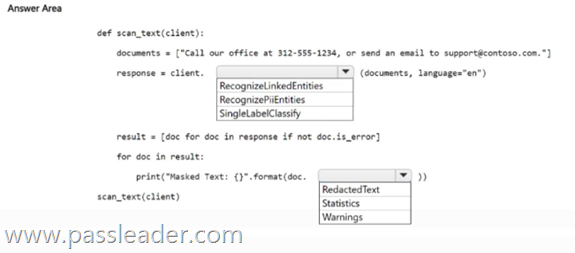
Explanation:
Box 1: RecognizePiiEntities. Runs a predictive model to identify a collection of entities containing Personally Identifiable Information found in the passed-in document, and categorize those entities into types such as US social security number, driver’s license number, or credit card number.
Box 2: RedactedText. The characterMask policy allows the redactedText to be masked with a character, preserving the length and offset of the original text. This behavior is the existing expectation.
https://learn.microsoft.com/en-us/dotnet/api/azure.ai.textanalytics.textanalyticsclient.recognizepiientities
https://learn.microsoft.com/en-us/azure/ai-services/language-service/personally-identifiable-information/how-to/redact-text-pii
NEW QUESTION 463
HotSpot
You are building an agent by using the Azure AI Agent Service. You need to ensure that the agent can access publicly accessible data that was released during the past 90 days. How should you complete the code? (To answer, select the appropriate options in the answer area.)
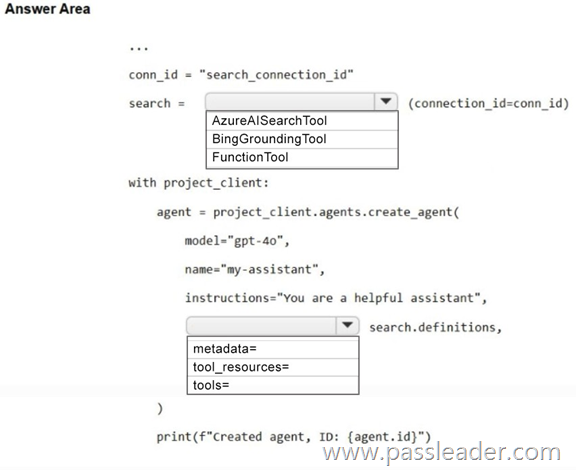
Explanation:
Box 1: BingGroundingTool. Grounding with Bing Search allows your Azure AI Agents to incorporate real-time public web data when generating responses. You need to create a Grounding with Bing Search resource, and then connect this resource to your Azure AI Agents. When a user sends a query, Azure AI Agents decide if Grounding with Bing Search should be leveraged or not. If so, it will leverage Bing to search over public web data and return relevant chunks. Lastly, Azure AI Agents will use returned chunks to generate a response.
Box 2: tools=. Create an Agent with the Grounding with Bing search tool enabled. To make the Grounding with Bing search tool available to your agent, use a connection to initialize the tool and attach it to the agent.
https://learn.microsoft.com/en-us/azure/ai-services/agents/how-to/tools/bing-grounding
https://learn.microsoft.com/en-us/azure/ai-services/agents/how-to/tools/bing-code-samples?pivots=python
NEW QUESTION 464
Drag and Drop
You are building a phone call handling solution that will use the Azure AI Speech service and a custom neural voice. You need to create a custom speech model. Which five actions should you perform in sequence from Speech Studio? (To answer, move the appropriate actions from the list of actions to the answer area and arrange them in the correct order.)
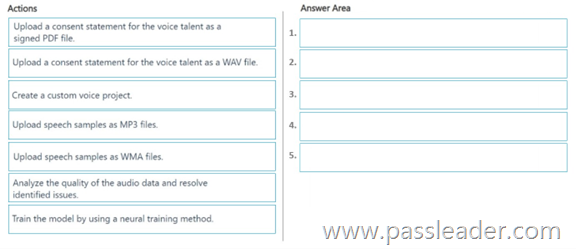
Explanation:
https://learn.microsoft.com/en-us/azure/ai-services/speech-service/how-to-custom-speech-create-project
https://learn.microsoft.com/en-us/azure/ai-services/speech-service/professional-voice-create-consent
NEW QUESTION 465
Drag and Drop
You have an Azure subscription that contains an Azure OpenAI resource named AI1. You need to analyze an image to obtain a text description. Which four actions should you perform in sequence from Azure OpenAI Studio? (To answer, move the appropriate actions from the list of actions to the answer area and arrange them in the correct order.)
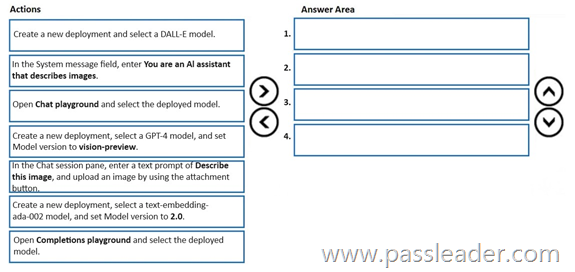
Explanation:
1. Create a new deployment and select a DALL-E model. (DALL-E models are designed to work with image generation and analysis, which is necessary to obtain a text description from an image.)
2. In the System message field, enter “You are an AI assistant that describes images”. (Setting up the system message clarifies the task for the model, specifying its role in the interaction.)
3. Open Chat playground and select the deployed model. (The playground allows you to interact with the deployed model.)
4. In the Chat session pane, enter a text prompt of “Describe this image” and upload an image by using the attachment button. (This step enables interaction with the model by providing the image and the instruction to describe it.)
NEW QUESTION 466
Drag and Drop
You have an Azure subscription that contains an Azure AI Search instance named AISearch1. AISearch1 contains an index that includes a vector. You need to perform the following actions:
– Deploy a new agent by using the Azure AI Agent Service.
– Connect the AISearch1 index to the new agent.
– Validate the integration of the index and the agent.
Which four actions should you perform in sequence? (To answer, move the appropriate actions from the list of actions to the answer area and arrange them in the correct order.)

Explanation:
https://learn.microsoft.com/en-us/azure/ai-services/agents/how-to/tools/azure-ai-search
NEW QUESTION 467
……
Get the newest PassLeader AI-102 VCE dumps here: https://www.passleader.com/ai-102.html (481 Q&As Dumps)
And, DOWNLOAD the newest PassLeader AI-102 PDF dumps from Cloud Storage for free: https://drive.google.com/drive/folders/1DtLmjMoVidk2fNQdkrtdSFHqFqxHU7re

